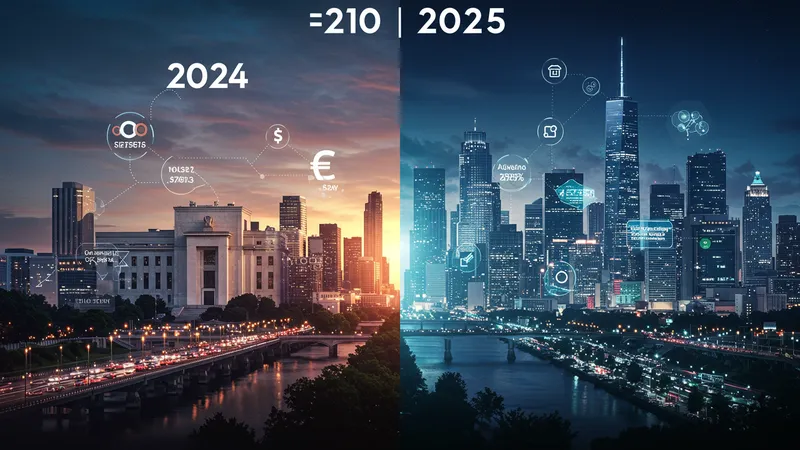

The landscape of finance can change dramatically from one year to the next, and in the United States, comparing financial trends between two consecutive years reveals how quickly priorities and strategies evolve. In 2024, the financial industry is responding to signals of inflation moderation, adjustments by the Federal Reserve, and a vibrant but cautious investing climate. By contrast, projections for 2025 suggest an increased focus on sustainable finance, refined interest rate policies, and a heightened embrace of digital assets and automation. This prompts an in-depth exploration of what differentiates finance in 2024 from what observers anticipate for 2025, specifically within the US context.
At the heart of these differences are shifts in consumer behavior, regulatory updates, technology innovation, and macroeconomic directives. In 2024, the US market sees cautious optimism, with businesses and individuals adapting to post-pandemic norms and new economic policies. By 2025, experts expect a greater emphasis on integrating automation in banking, expanding access to green financing, and optimized digital tools for everyday financial management. Understanding these nuanced shifts is crucial for anticipating opportunities and minimizing risks.

One major difference already visible is the pace at which digital finance is being adopted. In 2024, mobile banking apps and integrated financial dashboards are widely used, but 2025 is poised to bring broader AI implementation, making recommendations and automating choices smarter and more precise. For instance, banks like Chase are updating their platforms to include tailored advice and automated saving mechanisms, which could set a new standard by the end of 2025.
Investment strategies also show a marked evolution. The popularity of diversified ETFs such as those offered by Vanguard remains rock-solid in 2024, yet 2025 is expected to see retail investors using real-time analytics and more sophisticated portfolio-balancing tools, influenced by both emerging regulation and advancing technology. As inflation and interest rates fluctuate, these tools may better support consumer and institutional adaptation to an ever-changing environment.
In the digital asset space, companies like Coinbase are setting the tone for user-friendly crypto investment and trading in 2024. The regulatory environment is projected to become more defined by 2025, encouraging mainstream adoption while increasing consumer protections. These advancements could influence which digital assets become widely accepted and how they are incorporated into traditional portfolios.
Another driving factor is the regulatory and macroeconomic framework. Regulations in 2024 are shifting to address new payment methods, privacy, and risk, while 2025’s anticipated reforms may bring stricter oversight for digital assets and innovative banking products. Businesses and consumers will need to stay agile, watching for regulatory updates and adapting financial strategies promptly to stay compliant and effective.
While these trends introduce fresh complexities, they also offer new pathways for growth and financial wellbeing. The deeper details reveal even more valuable insights ahead as the nuances between finance in 2024 and 2025 in the US come into sharper focus, influencing decisions at every level.
Banking in the United States has rapidly evolved, with 2024 marking widespread adoption of digital banking platforms. Financial institutions like Chase lead this trend, offering customer-centric mobile experiences and robust online tools. In 2024, consumers gravitate toward seamless interfaces, quick transfers, and secure digital interactions. Branchless banking is gaining traction, but physical branches remain valuable for complex needs.

Looking toward 2025, experts project a more intelligent layer atop the digital banking foundation. Artificial intelligence is expected to play a larger role in managing transactions, flagging unusual activity, suggesting saving strategies, and personalizing recommendations. These enhancements are designed to simplify financial decision-making and encourage better habits among US consumers.
The tools offered by banks are anticipated to be integrated with other aspects of users’ financial lives, such as budgeting, investment management, and even financial wellness advice. Banks that successfully bridge these systems will be positioned at the forefront of the industry by 2025. The Chase Digital Banking platform, for example, is rolling out embedded features that could redefine user engagement and trust.
US customers continue to value safety, speed, and transparency. As digital banking matures in 2025, regulators are likely to impose stricter standards on user authentication and data privacy. This evolution could drive banks and fintechs to innovate in security measures, balancing rapid access with robust protection, and setting new expectations for the market.
Investment trends in 2024 emphasize broad market exposure, low-fee funds, and resilience against short-term volatility. The Vanguard Total Market ETF is emblematic of these priorities, allowing everyday US investors to capture the performance of the entire US equity market at a minimal cost. In this environment, accessibility and simplicity are paramount, attracting both new and seasoned investors.

The shift to 2025 is expected to bring a stronger focus on analytics-driven investing. As fintech tools evolve, retail and institutional investors will likely gain access to more granular data, real-time performance tracking, and predictive modeling. This could allow portfolio management to go beyond simple diversification, using machine learning insights to optimize asset allocation dynamically.
As inflation and interest rates fluctuate, adaptive strategies could become essential. Investors are expected to utilize tools that automatically rebalance portfolios or suggest tactical adjustments based on preset risk levels. The lasting appeal of core ETFs like Vanguard’s products is not expected to fade, but the ways investors interact with them may become more sophisticated and personalized.
US regulators may further influence product offerings and transparency standards in 2025, introducing additional reporting requirements or disclosure of risk factors. These changes would aim to support informed investing while maintaining market stability in an increasingly automated landscape.
The US crypto market in 2024 is characterized by increased retail participation and improved access via platforms such as Coinbase. Despite fluctuating asset values, growing familiarity among consumers and institutional investors supports the sector’s momentum. The regulatory environment remains somewhat uncertain, with ongoing discussions around classification, taxation, and consumer protections.

Looking ahead to 2025, federal agencies and lawmakers are anticipated to bring greater clarity to the regulatory framework. This could promote responsible growth, protect consumers, and foster more stable participation from established financial institutions. As a result, the digital asset sector may shift closer to mainstream finance, with wider acceptance for certain digital currencies and tokenized assets.
Advancements in blockchain technology are also expected to streamline payments, reduce transaction times, and lower costs. Companies operating in the space will likely compete by enhancing security and onboarding simplicity. In this context, platforms like Coinbase may become integral to routine financial activities, not just speculative investment.
This evolution could reshape portfolio management and encourage the blending of traditional and digital assets. The growing acceptance of cryptocurrencies as part of diversified long-term strategies signals an important transition in the US market, with new standards for risk assessment and portfolio composition on the horizon.
Evolving policy is an ever-present factor in US finance. In 2024, regulatory authorities are focused on responding to tech-driven changes, data privacy, and protecting against emerging financial threats. These actions shape the services and products available, ensuring consumer trust remains high even as innovation accelerates.

By 2025, the regulatory spotlight is expected to rest more squarely on digital assets, green financing, and fair lending standards. Lawmakers may pursue targeted reforms on tax transparency, requirements for reporting crypto holdings, and incentives for sustainable investment. This progression is likely to affect both institutional strategies and the everyday choices of consumers.
Macroeconomic variables—such as inflation rates, employment trends, and GDP growth—continue to influence US finance year over year. In 2024, dealing with resulting interest rate adjustments and shifts in borrowing costs presents both challenges and openings. The expectation for 2025 is ongoing adaptation, with stakeholders using smarter tools and strategies to remain agile in volatile conditions.
The interplay of regulation, economics, and technological advances will shape the future of finance in the US. Understanding these dynamics empowers individuals and organizations to navigate the shifting landscape and make informed, strategic choices as 2024 gives way to 2025.